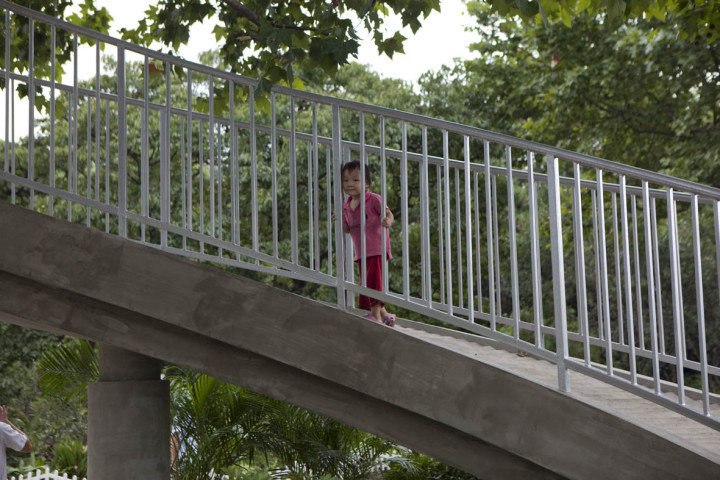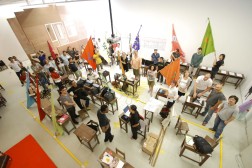



Treehugger Project at Changfeng Park in Shanghai
Opening Ceremony: September 4th at 3:00 pm
Press Conference: September 4th at 4:30 pm
Location: Gate #4 Changfent Park, Daduhe Lu
Treehugger by Dutch conceptual artist Edwin Zwakman has now found a permanent home in the Putuo District of Shanghai. The ribbon cutting will be hosted by Governor of Shanghai Putuo District People’s Government, Mr. Sun Rongqian and Consul General of the Netherlands in Shanghai, Mr. Eric Verwaal.
The Dutch conceptual artist and photographer Edwin Zwakman fulfilled an artist-in-residency in Beijing last year and it was then that he developed a great interest in Chinese daily life at street level and the extensive park culture of big Chinese cities. It inspired him to design Treehugger. The artwork uses the iconic form of a pedestrian bridge, taken out of context, to circle a live tree, providing a unique experience for the public to appreciate the tree at different levels.
Many Chinese cities lead their pedestrians through heavy traffic via stairs and bridges. To see the design in a different context than the usual urban landscape, can at first sight be confusing. But the unexpected poetic experience and the different point of view it offers the spectator–in this case in between the leaves of a tree–is what Zwakman’s work is famous for.
Treehugger is placed on a striking spot in Changfeng Park in Putuo district, Shanghai. This park was founded in 1956 and is one of the biggest and oldest parks in Shanghai. It is a landscape park which accommodates more than 160 kinds of plants, a man-made lake and it hosts the annual China Flower Expo. The park already features several public space artworks, and therefore is the perfect place to welcome Treehugger.
Arthub Asia is a proud partner of this project, along with OCT, FondsBKVB, DCC and the Consulate General of the Netherlands.
Edwin Zwakman
Rendering Real–New Work in China
Dutch conceptual artist and photographer Edwin Zwakman has made his fame with photographs of diligently constructed cardboard models that look vigorously real/fake, but accurate, as one of his most recent solo exhibitions suggests. As constructed universes, Edwin Zwakman’s photographs share a quality that goes beyond the mere accuracy allowing for a lapse in perception to take place in the heads of its spectators.
The stillness and awkwardness inside the image transforms the portrayed landscape into a poetic standstill, a subtle reflection, giving way to the kind of alienation that one experiences when landscape steps out of the background and assumes an uncomfortable presence, or when a sudden awareness arises over the things surrounding us, that we normally hardly notice. From this perspective, Zwakman’s photographs do not have the intention to trick us; rather, they show us how what we consider to be real, plays tricks on us.
In his in-situ work, Zwakman explores similar mechanisms, and once again he makes use of symbolic and/or poetic imagery to instigate the confusion that characterizes his work. Whether subtle or not, Edwin Zwakman’s reconfigurations and interventions in public space create a sense of alienation that makes for the audience to re-boot its view of the world–in the blink of an eye, momentarily, as a snapshot. Following this logic, Zwakman’s in-situ work can be read as a collection of temporary snapshots, only now he is not taking the picture, but the random passenger is.
In China’s urban metropolises, it seems as if reality needs to be rendered first, before it can actually come into being. Massive billboards and advertisement campaigns announce the look of the new China in flashy renders and miniature models that once constructed and inhabited might turn out to look quite the opposite. The political power of the branded, rendered image, the poignant differences with the realization of it and the two parallel realities they eventually become, provides a fascinating case to study in China when scouting the borderlines between fake real and real fake. It is one of the main research scopes of Edwin Zwakman’s residency in Beijing.
With the Treehugger project to be realized in the coming months in Beijing, Zwakman applies another recurrent strategy in his work: to re-adjust the use of a symbol or an object and copy-paste it next to another, creating as a result a somewhat estranging encounter. The city’s numerous passenger bridges are taken out of context and simulated around a tree. But the Treehugger project also involves a reflection on the dichotomy between the above mentioned real and rendered real, and so he will alter an intervention in public space with reproductions or renders in a white cube setting. Or was it the other way round?
Edwin Zwakman will give a lecture presentation on his work at Beijing University on May 8th at 7:00 pm and in the Central Academy of Fine Arts on May 15th at 7:00. For more information contact Liu Gang at: liu@theatreinmotion.org.
With the Treehugger project to be realized during the Expo 2010 in Shanghai, Arthub continues to host Edwin Zwakman at Arthub studios during his preparations. In his first trip, Edwin Zwakman resided in Beijing with Theatre in Motion.
His project is sponsored by OCT, FondsBKVB and DCC.
